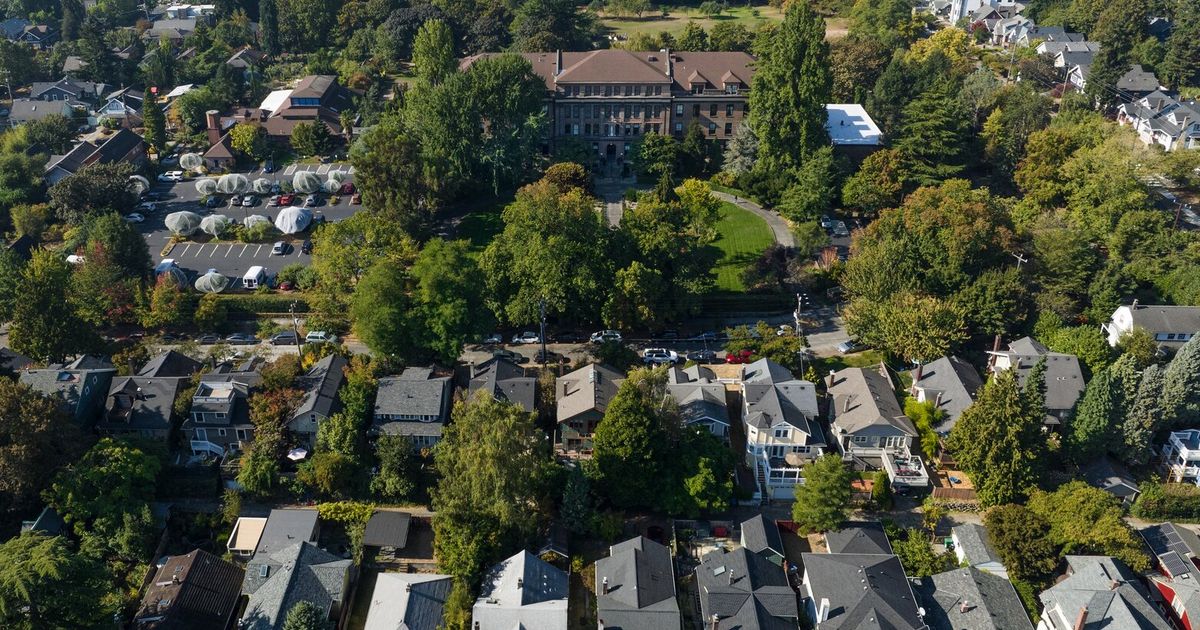There’s an appealing simplicity to the idea of converting office buildings into housing.
The premise suggests cities could solve two problems — an office glut and a housing shortage — at once. In the process, they could limit the waste of demolition, create new homes with minimal opposition, and renew neighborhoods without radically changing how they look from the sidewalk.
The idea, however, is less like a sweeping fix and more like a set of intricate puzzles — a different one for each building. Each one must solve for local rules that say what counts as a bedroom, for structural columns and elevator shafts that shape where walls go, for construction costs and land prices that affect rent rolls. And they must solve, above all, for access in every unit to fresh air and sunlight.
For many offices, this puzzle may be unsolvable, at least for now.
But for others it is not impossible, even in large modern buildings, even on pricey Manhattan land. And to understand the potential of conversions — and why older buildings often make easier ones — it’s useful to look closely at a pair of buildings constructed 40 years apart, and the evolution of the American office that runs through them.
The prewar skyscraper playbook
Buildings around the country that have already been converted from offices to housing — using tax credits and other local incentives that predated the pandemic — tend to have a similar look. They resemble the Philadelphia building: historical charm, a slender shape, high ceilings, punched windows.
These kinds of buildings, often dating to the early 20th century, make for simpler conversions because the same logic that shaped how they were designed as offices a century ago determines how apartments are planned today. Both share a rule of thumb that no interior space be more than 25 to 30 feet from a window that opens.
Apartments, obviously, need operable windows to vent cooking fumes and brighten living space. In the early 20th century, offices needed functioning windows, too, for cooling on hot days before air conditioning and to illuminate workspaces before modern lighting. In either context, any space more than 30 feet from a window starts to feel cavelike.
Iconic prewar skyscrapers like the Empire State Building were designed to this standard, and with this smallest unit in mind: a single rentable office 10 to 20 feet wide and about 28 feet from the windows to the common corridor. That was just the right amount of space for a receptionist’s anteroom and a windowed office.
Dan Kaplan, a senior partner with the architecture firm FXCollaborative in New York, identifies the private eye suite in any film noir as a classic example: frosted glass doors, a secretary framed by interior transom windows, and then the detective in his private office flooded with natural light.
String together a row of these suites along both sides of a long corridor (with a shared elevator lobby and bathrooms), and many of these older office buildings form narrow rectangular boxes. Some were designed with multiple wings of office corridors. They might appear rectangular from the street, but viewed from above, they evoke letters — an H, O, C, U, I or L.
Such floor plans and building shapes translate well to apartments (although, of course, a common bathroom for 20 units won’t do). Buildings like these also have two more related advantages. They already have the operable windows required in housing, unlike the climate-controlled modern offices sealed behind glass curtain walls.
And the economics of conversion make more sense with prewar buildings. Older offices have largely fallen out of favor with tenants who prefer modern amenities and large open spaces that can be easily reconfigured. That means the value of these buildings as offices has fallen low enough that in some locations they might command higher rents as housing.
It’s an elegant circle of city life: The very qualities that have made these buildings outdated as offices now make them ideal candidates for apartments.
“Geometry is where I always start,” said Leo Addimando, the developer with Alterra Property Group, which converted the 275,000-square-foot building into 206 apartments in 2014. Here, that geometry starts with the building’s long, narrow shape, with operable windows on all four sides of the primary office floors.
Inside, the apartments feel, well, like apartments — like spaces designed for people and not cubicles or filing cabinets.
Look at enough old office buildings, even just appraising their shapes and windows from the street, and it’s not hard to identify which ones might make this metamorphosis more easily. How long does it take Addimando to size up a building’s basic geometry? “Thirty seconds,” he said.
Modern offices are trickier
But the conversion puzzle gets more complex with offices built after World War II. That’s because the modern office has strayed far — increasingly far — from the window rule.
Two inventions liberated office space from the window: air conditioning and the fluorescent lightbulb. Just as the elevator and steel-cage construction enabled buildings to grow taller in the late 19th century, architectural historian Carol Willis has written, fluorescent lighting and air conditioning enabled their floor plates to become much deeper.
That suited increasingly large companies in the postwar era that wanted more space for trading floors, law libraries and cubicle farms. (There was also little concern about the cost of lighting and cooling such vast offices during an era of cheap energy.) The old private eye office was maybe 600 square feet in size. Larger corporations wanted 25,000 square feet per floor — and multiple floors of it. Today, new office towers promote their “large floor plates” right alongside their prime locations and terrace views.
As offices, these buildings can also rent 100% (or even more) of their total square footage, according to the quirky math of commercial real estate. That’s because some companies rent entire floors, but also because office tenants — unlike apartment renters — typically pay additional rent for shared building spaces beyond their suites.
To convert any of these properties to apartments, you’d have to add common corridors, bike storage, lounges, a gym — features that take up space but don’t collect rent (at least, not explicitly). In a typical residential building, only 80% to 85% of all square footage is considered rentable. That makes conversions particularly unappealing to many office owners.
These challenges with the physical characteristics of big buildings — and the accounting of how you might carve them up — are universal. “A deep office floor plate is just as hard here as it is in Kansas,” said Robert Fuller, a principal and studio director with the architecture and design firm Gensler based in New York.
Then local rules add still more complexity: Maybe the building has to meet stricter seismic requirements as an apartment than as an office (much of the West Coast), or the whole facade must be replaced to meet current wind-load standards (hurricane-prone places). Or you can only convert 18 of the 32 existing office floors into residential use (in Manhattan, such use caps depend on a building’s age and location). Or units must average at least 500 square feet in size per building (downtown Chicago). Or every legal bedroom must have its own working window (New York requires this, but Philadelphia and San Francisco don’t).
Together, these constraints increase the cost of conversion and reduce the possible forms it can take. It’s still possible to turn bigger, boxier offices into apartments. Here, however, things start to get harder, much more expensive and a little wild — as the conversion at 180 Water St. in New York shows.
The 457,000-square-foot building in the financial district was completed in 1970 and converted to housing in 2017 by the developers Metro Loft Management and Vanbarton Group. To solve for the unusable interior space, the builders cut a hole from the center of the building, opening new windows onto an interior courtyard.
From outside on the street, it’s impossible to tell this building has a hole sliced from the center of it. But that hole provides yet another key piece of the property’s economic puzzle.
The developers were allowed to convert the entirety of 180 Water into housing under zoning rules eased in the 1990s to spur conversions in the financial district. And so they took an equivalent volume cut from the building’s center and repurposed it for floors (and rental income) added to the building’s top.
The apartments that result from all of this don’t exactly resemble what you’d get if someone constructed a new residential building on an empty lot. And the resulting rents aren’t cheap, ranging today from $3,500 to $7,000 a month. Conversions in Manhattan tend to create market-rate “luxury” rentals, or condos selling for $3 million to $4 million.
That’s in part because in New York and many other markets, it’s hard to cover the costs of conversion while producing housing affordable to middle-class or lower-income residents. “Without public policy, without the city offering incentives, it just economically is not viable,” said Nathan Berman, the head of Metro Loft (the city’s own conversion task force concluded the same).
That could change with tax abatements and subsidy programs, or if outdated office buildings lose so much value that the cost of acquiring them plummets.
“Nobody just yet is giving these buildings away,” Berman said.
Developers and architects who’ve been doing this niche work for years say that few conversions are physically impossible if you’re creative enough. But the economics and the regulations aren’t as malleable. That’s where cities have some power to make these puzzles simpler.
In addition to creating economic incentives, they could relax the zoning distinctions between office and residential uses, or rethink the rules that say how much green space an apartment needs or where its windows must be. In New York, Mayor Eric Adams has proposed extending to many more buildings the relaxed rules that helped make 180 Water possible.
Such changes would not single-handedly solve any city’s housing woes, or fill all of its office vacancies. But both problems ultimately require more than one fix anyway. And eventually, these challenges confronting cities now will only get harder, as today’s massive offices age.
“There’s going to come a time when those buildings will become dated, and what do you do with a million-square-foot building?” said Ron Caplan, a developer who has converted offices up and down the East Coast. “If I were going to sit lying awake at night trying to figure things out, that would be one I absolutely don’t know how to solve.”
















